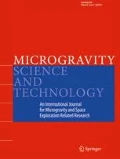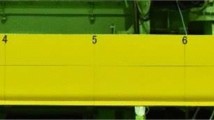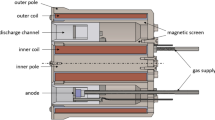Abstract
Ground-based freefall facilities are to create microgravity environment on earth for studying the space-related or fundamental sciences, which have been widely used in the field of combustion, fluid, physics and material sciences. Aiming to serve for the broader microgravity science and preliminary tests for projects onboard the upcoming assembly of Chinese Space Station, a 2.2 second freefall facility was designed and built in the Lee Shau Kee Science and Technology Building on the campus of Tsinghua University in Beijing. This facility is composed of five systems: (I) freefall tunnel and safety cables; (II) release and retrieve system; (III) the capsule; (IV) brake system; (V) electrical control and safety interlock system. The capsule consists of an outer drag shield and an inner rig of which the total weight is 280 kg. The capsule is released by a pneumatic chuck that minimizes disturbance of the release operation. The eddy current brake modules made of several permanent magnets are applied to decelerate the capsule without power supply. This paper primarily discusses the tests designed and conducted to characterize the performance of such facility in many aspects. The results show that during freefall, the microgravity level of 10-3 g can be achieved for 2.2 second. Concerning movement of the inner rig relative to the drag shield during freefall, the clearance of 0.43 m and relative velocity of 0.62 m/s were specified. The deceleration can be controlled within 15 g. The terminal velocity of capsule in the brake system ranges from 0.4 to 0.5 m/s depending on the actual weight of capsule. The noise level in the entrance section of brake system is about 75.6 dB. The duration of this noise is very short (<1 s), suggesting that the operation of facility is environmentally friendly to the operators and people working in the building.





















Similar content being viewed by others
Abbreviations
- A :
-
cross area (m2)
- a :
-
acceleration (g)
- a d :
-
drag acceleration (m/s2)
- a x ,a y ,a z :
-
components of gravity acceleration in three directions (m/s2)
- B 0 :
-
magnetic flux density at the entry edge (T)
- B rem :
-
magnet remanence of the magnet (T)
- C D :
-
drag coefficient
- d e :
-
entrefer length (de = dm + dg) (m)
- d g :
-
the depth of the air gap (m)
- d m :
-
the depth of the magnet (m)
- d sc :
-
half the thickness of the conductor plate (m)
- F B :
-
the total braking force of the capsule (N)
- F D :
-
drag force(N)
- F e :
-
the braking force on the conductor plate from the entry-edge field (N)
- F g :
-
gravity force of the capsule (N)
- F r :
-
the contributions of the rth harmonic to the tangential (braking) force (N)
- g:
-
gravity acceleration (m/s2)
- g m :
-
measured gravity level (g)
- K 0 :
-
offset value (10-3 g)
- K 1 :
-
the 1st order scale factor (10-3A/g)
- K 2 :
-
the 2nd order scale factor (10-6/g)
- k :
-
k = π/τ (m-1)
- L :
-
relative displacement distance (m)
- l m :
-
magnet length (m)
- l p :
-
the length of primary plate (m)
- M pr :
-
magnetization amplitude of the rth harmonic (A/m)
- p :
-
number of pole pairs
- R :
-
resistance (kΩ)
- r :
-
the rth harmonic
- U out :
-
output voltage (V)
- u :
-
velocity (m/s)
- u d :
-
velocity of drag shield (m/s)
- u 0 :
-
u0 = 1/μ0σdsc (m/s)
- v :
-
the fractional velocity (v= u/u0)
- θ :
-
rotation angle (rad)
- μ 0 :
-
permeability of vacuum (T∙m/A)
- ξ :
-
correction factor of the magnet field (ξ =1.3)
- σ:
-
effective conductivity of the conductor plate (S/m)
- σp :
-
physical conductivity of the conductor plate (S/m)
- τ:
-
pole pitch (m)
- ψ, φ :
-
misalignment angle (rad)
- ωp :
-
the width of primary plate (m)
- ωsc :
-
the width of the conductor plate (m)
References
Dietrich, D.L., Nayagam, V., Hicks, M.C., Ferkul, P.V., Dryer, F.L., Farouk, T., Shaw, B.D., Suh, K.H., Choi, M.Y., Liu, Y.C., Avedisian, C.T.: Droplet combustion experiments aboard the international space station. Microgravity Sci. Technol. 26(2), 65–76 (2014)
Dittus, H.: Drop tower ‘Bremen’: a weightlessness laboratory on Earth. Endeavour 15(2), 72–78 (1991)
Edwards, J.D., Jayawant, B.V., Dawson, W.R.C., Wright, D.T.: Permanent-magnet linear eddy-current brake with a non-magnetic reaction plate. IEE Proceedings-Electr. Power Appl. 146(6), 627–631 (1999)
Farouk, T.I., Dryer, F.L.: Isolated n-heptane droplet combustion in microgravity: “Cool Flames”–two-stage combustion. Combust. Flame 161(2), 565–581 (2014)
Ferkul, P., Sacksteder, K.R., Greenberg, P.S., Dietrich, D.L., Ross, H.D., Tien, J.S., Altenkirch, R.A., Tang L., Bundy, M., Delichatsios, M.: Combustion experiments on the Mir space station. AIAA Aerospace Sciences Meeting and Exhibit 439 (1999).
Hang, X.: First experiments selected for China’s Space Station. Aerospace China (2019)
Hu, W.R., Zhao, J.F., Long, M., Zhang, X.W., Liu, Q.S., Hou, M.Y., Kang, Q., Wang, Y.R., Xu, S.H., Kong, W.J., Zhang, H., Wang, S.F., Sun, Y.Q., Hang, H.Y., Huang, Y.P., Cai, W.M., Zhao, Y., Dai, J.W., Zheng, H.Q., Duan, E.K., Wang, J.F.: Space program SJ-10 of microgravity research. Microgravity Sci. Technol. 26(3), 159–169 (2014)
Hu, W., Kang, Q., Duan, E., Long, M.: SJ-10 recoverable satellite for space microgravity experiments. Chin. J. Space Sci. 40(5), 648–654 (2020)
Huang, Y., Mao, W.: First results derived from a drop-tower testing system for granular flow in a microgravity environment. Landslides 10(4), 493–501 (2013)
Iwakami, T., Nokura, M.: Micro-Gravity Experiments at Micro-Gravity Laboratory of Japan (MGLAB). Int. Astronaut, Congr (2005)
Koide, A.: JAMIC drop-shaft type microgravity facility accommodating 10-seconds microgravity. Journal of the Japan Society of Microgravity Application 18, 136–139 (2001)
Kong, W., Wang, B., Lao, S., AI, Y.: Study on fire initiation of wire insulations on board the satellite, Chin. J. Space Sci. 28(1), 28–32 (2008)
Kong, W., Wang, K., Xia, W., Xue, S.: Ignition and combustion characteristics of overloaded wire insulations under weakly buoyancy or microgravity environments. In: Hu, W., Kang, Q. (eds.) Physical Science Under Microgravity: Experiments on Board the SJ-10 Recoverable Satellite, pp. 191–235. Springer, Singapore (2019)
Kumagai, S.: Combustion of fuel droplets in a falling chamber with special reference to the effect of natural convection. Jet Propul. 26(9), 786–786 (1956)
Kumagai, S., Isoda, H.: Sixth Symposium (International) on Combustion. The Combustion Institute 726. (1957)
Kumagai, S., Sakai, T., Okajima, S.: Combustion of free fuel droplets in a freely falling chamber. Symp. (Int.) Combust. 13(1), pp. 779–785 (1971)
Lämmerzahl, C., Steinberg, T.: Drop towers. In: Beysens, D.A., van Loon, J.J. (eds.) Generation and Applications of Extra-Terrestrial Environments on Earth, pp. 45–73. River Publishers, Aalborg, Denmark (2015)
Li, C., Zhao, H., Ni, R.: China’s recoverable satellites and their onboard experiments. Microgravity Sci. Technol. 20(2), 61–65 (2008)
Liu, T.Y., Wu, Q.P., Sun, B.Q., Han, F.T.: Microgravity level measurement of the Beijing drop tower using a sensitive accelerometer. Sci. Rep. 6, 31632 (2016)
Lotz, C., Kämper, T., Berlin, H., Overmeyer, L.: Innovative drive and guide concept for experiments under microgravity in the Einstein-Elevator. Symposium on Automated Systems and Technologies (AST) 4, 1–12 (2014)
Lotz, C., Froböse, T., Wanner, A., Overmeyer, L., Ertmer, W.: Einstein-Elevator: A new facility for research from μg to 5 g. Gravit. Space Res. 5(2), 11–27 (2020)
Mori, T., Goto, K., Ohashi, R., Sawaoka, A.B.: Capabilities and recent activities of Japan Microgravity Center (JAMIC). Microgravity Sci. Technol. 5(4), 238–242 (1993)
Nayagam, V., Dietrich, D.L., Ferkul, P.V., Hicks, M.C., Williams, F.A.: Can cool flames support quasi-steady alkane droplet burning? Combust. Flame 159(12), 3583–3588 (2012)
NASA: Skylab experiment, Volume 3, Materials science. https://files.eric.ed.gov/fulltext/ED091215.pdf (1973)
Neumann, E.: Zero Gravity Research Facility at NASA Glenn Research Center. https://www1.grc.nasa.gov/facilities/zero-g/ (2006)
Neumann, E. 2.2 second drop tower at NASA Glenn Research Center. https://www1.grc.nasa.gov/facilities/drop/ (2008)
Neumann, E.: Zero Gravity Research Facility User's Guide. https://www1.grc. nasa.gov/wp-content/uploads/Zero-Gravity- Research-Facility-users-guide.pdf (2017)
Nikhil, V.V., Nair, A., Niketh, P., Kumar, A., Muruganandam, T.M.: The 2.5 s microgravity drop tower at national centre for combustion research and development (NCCRD), Indian Institute of Technology Madras. Microgravity Sci. Technol. 30(5), 663–673 (2018)
Nokura, M.: Improvement plan of the electrical equipment in MGLAB. Journal of the Japan Society of Microgravity Application 25(3), 629–634 (2008)
O'Malley, T.F., Sheredy, W.A., Stocker, D.P.: Combustion Research on the International Space Station. Int. Astronaut. Congr. IAC08-A2.1.07 (2008)
Ross, H.D.: Burning to Go: Combustion on Orbit and Mars. Chem. Phys. Processes Combust. 29–38 (1997)
Steinberg, T.: Reduced gravity testing and research capabilities at Queensland University of Technology’s New 2.0 Second Drop Tower. Adv. Mater. Res. 32, 21–24 (2008)
Steinberg, T.: Microgravity Drop Tower: Science and Engineering Faculty. https://www.qut.edu.au/research-all/research-projects/microgravity-drop-tower (2016)
Wang, K., Xia, W., Wang, B., Kong, W.: Fire initiation characteristics of wire insulation in representative weakly buoyancy environment. Chin. J. Space Sci. 36(4), 501–507 (2016)
Wang, S., Yin, Y.: Microgravity smoldering combustion experiments aboard the china recoverable satellite S J-8. Chin. J. Space Sci. 28(1), 22–27 (2008)
Wang, S., Zhu, F.: Flame spread in low-speed forced flows: ground-and space-based experiments. In: Hu, W., Kang, Q. (eds.) Physical Science Under Microgravity: Experiments on Board the SJ-10 Recoverable Satellite, pp. 237–262. Springer, Singapore (2019)
White, F.M.: Fluid Mechanics, 7th edn., p. 491. McGraw-Hill, New York, USA (2009)
Wollman, A.P.: Capillarity-driven droplet ejection, Master dissertation, Portland State University (2012)
Wollman, A.P., Weislogel, M.: New investigations in capillary fluidics using a drop tower. Exp. Fluids 54(4), 1499 (2013)
Xie, J., Wan, S., Zhang, P., Lin, H., Liu, F., Hu, W.: Achievements of space scientific experiments aboard SJ-8 satellite. Chin. J. Space Sci. 28(5), 390–394 (2008)
Yin, Y., Wang, S., Liu, R., Yang, J., Zhu, F., Tian, L.: Experimental facility for ignition and burning of solid materials aboard SJ-10 satellite. Chin. J. Space. Sci. 36(4), 492–496 (2016)
ZARM FABmbH: User Manual: Drop Tower Bremen. https://www.zarm.unibremen.de/fileadmin/user_upload/drop_tower/ Users_Manual_0412.pdf (2011)
Zhang, H., Chen, J., Zhang, P., Liu, B., Zuo, C., Qiao, Y.: Current status and future prospects on microgravity coal combustion. Chin. J. Space Sci. 36(4), 469–475 (2016)
Zhang, X., Yuan, L., Wu, W., Tian, L., Yao, K.: Some key technics of drop tower experiment device of National Microgravity Laboratory (China)(NMLC). Science in China Ser. E Eng. Mater. Sci. 48(3), 305–316 (2005)
Zuo, C., Liu, B., Chen, J., Zhang, P., Qiao, Y., Xu, M., Liu, Q., Zhang, H.: Space program SJ-10 on coal combustion research at microgravity. Int. Symp. Coal Combust. 113–119. Springer, Singapore (2015)
Acknowledgement
This project is primarily supported by the start-up research funding of Prof. Yu Cheng Liu at Tsinghua University. Partial support from National Science Foundation of China (NSFC)- under Grant No. 51706120 and 52076117 for experimental apparatus on the inner rig is gratefully appreciated. We appreciate Profs. Claus Lämmerzahl, Claus Braxmaler, Michael Dreyer of ZARM (through connection of Prof. Qiu-Sheng Liu of Institutes of Mechanics, Chinese Academy and Sciences), Prof. Osamu Fujita of Hokkaido University, and Profs. Mitsuhiro Tsue and Shinji Nakaya of The University of Tokyo for offering visits to their microgravity facilities. Professor Yang Gao of Sun Yat-Sen University was involved in the preliminary planning of this facility while he was at Tsinghua. Professor Mark Weislogel of Portland State University was consulted during his visit to Tsinghua concerning the use of safety cables and magnetic brakes. We also thank Prof. Weislogel for providing updated materials of the Dryden Drop Tower in Table 1. Mrs. Binglei Duanmu, Xiaosong Bai, Mengxin Yang, Qingwu Zhang and many other engineers from AVIC CAPDI Integration Equipment Co., LTD are acknowledged for their devotion to implementing the designs. We thank Mr. Xiaogang He and Xiaohong He from School of Architecture, Tsinghua University for their viability analyses from the perspective of building structure. We appreciate Haiyong Yang of Tsinghua University for his coordination during the construction of LSKSTB. Many thanks to Prof. Wenjun Kong form Beihang University, Prof. Jianfu Zhao and Prof. Shuangfeng Wang from Institute of Mechanics, Chinese Academy of Sciences, Dr. Yang Yang and Dr. Jianquan Zhang from Technology and Engineering Center for Space Utilization, Chinese Academy of Sciences, Prof. Yuqun Zhuo and Prof. Hai Zhang from Department of Energy and Power Engineering of Tsinghua University for their pertinent suggestions for the development of TUFF’s operation procedure and safety regulations. Finally, we appreciate Prof. Qiang Yao of Tsinghua University for his persistent support for the development of microgravity combustion research and infrastructure in China, including the construction of TUFF.
Author information
Authors and Affiliations
Corresponding author
Additional information
Publisher’s Note
Springer Nature remains neutral with regard to jurisdictional claims in published maps and institutional affiliations.
Rights and permissions
About this article
Cite this article
Luo, L., Zhou, H., Sun, Y. et al. Tsinghua University Freefall Facility (TUFF): A 2.2 Second Drop Tunnel for Microgravity Research. Microgravity Sci. Technol. 33, 26 (2021). https://doi.org/10.1007/s12217-021-09877-5
Received:
Accepted:
Published:
DOI: https://doi.org/10.1007/s12217-021-09877-5




